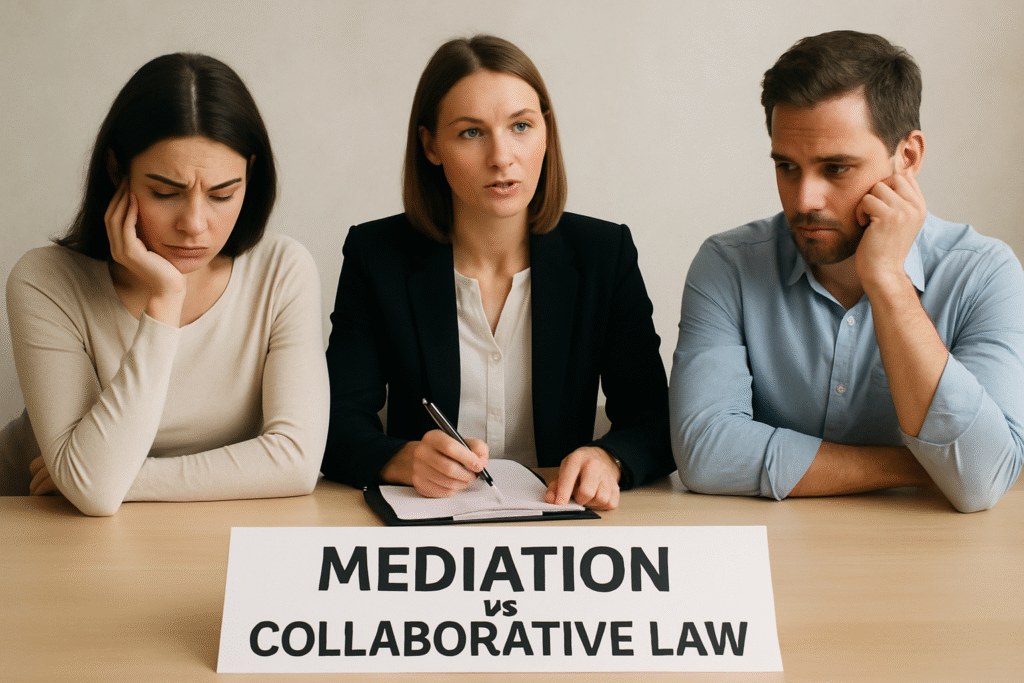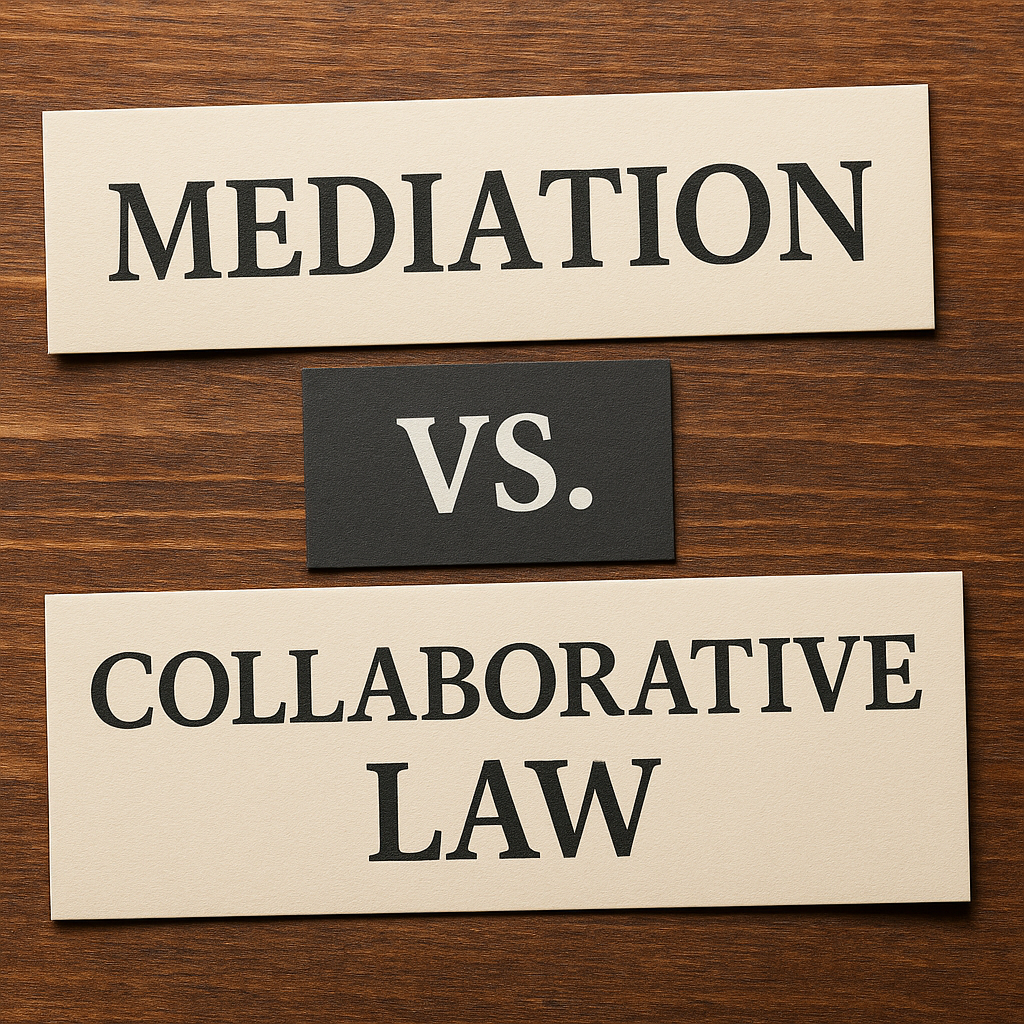Family law disputes often carry more than emotional weight—they bring financial consequences. For those seeking to resolve matters like divorce, child custody, or property division without courtroom litigation, the debate of mediation vs collaborative law becomes essential. Cost is frequently the deciding factor, especially for families aiming for an efficient, amicable resolution.
While both options fall under alternative dispute resolution (ADR), each follows distinct procedures, professional involvement levels, and fee structures. This article unpacks the cost comparison between mediation vs collaborative law in family legal conflicts, guiding first-time filers and financially-conscious parties toward better-informed decisions.
Understanding the Core Distinctions: Mediation vs Collaborative Law
The contrast between mediation vs collaborative law lies in structure, involvement, and strategy. Mediation typically involves a neutral third-party facilitator who helps both parties negotiate their differences. In contrast, collaborative law incorporates two attorneys—each representing one party—and may include other neutral professionals like child specialists or financial advisors.
This structural divergence directly influences total cost, not just in terms of professional fees, but also the duration of the process and likelihood of additional court involvement. According to the American Bar Association, mediation tends to be less formal, quicker, and more cost-efficient in many scenarios.
Initial Cost Comparison: Entry-Level Fees
When evaluating mediation vs collaborative law, the entry point for expenses is crucial. Mediation often starts at a lower flat-rate or hourly fee, especially when using court-connected services or private practitioners offering tiered packages. The average hourly rate for mediators can range from $100 to $400 depending on region and complexity.
On the other hand, collaborative law generally begins with retainer agreements for each attorney, often starting at $3,000–$5,000 per party. Additional charges accrue from the involvement of other professionals, such as neutral coaches or financial planners, whose fees may parallel attorney rates.

Billing Models and Their Financial Impact
The billing structures of mediation vs collaborative law drastically shape total expenditure. Mediation’s streamlined nature often translates into shorter case durations—an average of 2 to 5 sessions. Since both parties typically split the mediator’s cost, the burden is halved.
Collaborative law, conversely, involves multiple professionals billing separately. Even though it avoids courtroom litigation, the process may include numerous planning meetings, strategy sessions, and document reviews. Combined, these can push the total cost beyond $10,000–$15,000 per party, depending on dispute length and complexity.
Professional Involvement and Cost Escalation
Each added professional in a collaborative law team raises expenses. While this team-based model provides emotional, financial, and legal support, it comes at a price. For instance, a neutral financial professional may charge hourly or on a project basis—often $150 to $500 per hour. Child psychologists or divorce coaches similarly add to the total bill.
By contrast, mediation usually sticks to one facilitator. Even if parties seek outside legal advice, it’s often on an as-needed basis rather than embedded within the core process. This flexibility makes mediation financially attractive to those preferring leaner involvement.
Hidden and Indirect Costs to Consider
Though collaborative law aims for comprehensive resolution, it also has the risk of complete reset if negotiations break down. If either party terminates the process, both attorneys must withdraw per collaborative law agreements, forcing clients to retain new litigation counsel. This contingency significantly escalates cost and can delay proceedings.
Mediation, while not immune to failure, does not require the same withdrawal clause. If resolution is unreachable, either party may continue with independent counsel, avoiding duplicated attorney costs. This resilience provides a financial safeguard often overlooked when comparing mediation vs collaborative law.
Court Involvement and Filing Fees
Mediation often leads to quicker court filing due to consensus-based outcomes. Agreements reached in mediation are typically submitted jointly and approved with minimal judicial intervention. This keeps court-related fees and procedural delays at a minimum.
In collaborative law, while litigation is avoided, court filing remains necessary to finalize divorce or custody arrangements. The involvement of multiple attorneys may also result in more detailed legal drafting, increasing associated documentation and notary costs.
For reference, court filing fees in family law matters can be reviewed via the U.S. Courts official fee schedule, offering transparency on baseline costs involved post-resolution.

Time Investment as a Cost Factor
Time is often equated with money, and when comparing mediation vs collaborative law, session frequency and case longevity matter. Mediation may resolve in a matter of weeks if parties are cooperative. Collaborative law, by its nature, requires more extensive coordination—often dragging timelines into several months.
Longer timelines introduce more billable hours across multiple professionals, increasing indirect costs such as missed work, childcare, and administrative delays. Families juggling financial strain during separation often lean toward time-sensitive solutions, which makes mediation more appealing.
Cost Efficiency Based on Dispute Type
Not every family dispute is suited for either model equally. Mediation proves cost-effective in relatively low-conflict cases—uncontested divorces, parenting plan revisions, or spousal support negotiations. In contrast, collaborative law may be financially justified where emotional complexity or financial entanglement demands holistic intervention.
For example, high-asset divorces or long-term marriages with co-owned businesses often benefit from collaborative input. Still, this efficiency is proportional to the value of the marital estate rather than its affordability for middle-income families.
Geographic Price Variation and Market Rates
Another critical dimension in evaluating mediation vs collaborative law costs is location. In urban centers, both services see inflated pricing. Mediation may start at $300/hr in Los Angeles, while collaborative law retainers in San Francisco or New York City can exceed $10,000 just for preliminary representation.
By contrast, rural or suburban regions may offer more affordable rates for both models, though availability of collaborative professionals may be limited. Accessibility impacts affordability—families in remote areas may default to mediation out of necessity, not just cost-efficiency.
Cost-Control Strategies Within Both Models
Whether parties choose mediation or collaborative law, controlling cost requires strategic decisions. In mediation, clear preparation, document organization, and realistic negotiation goals reduce time spent. Collaborative participants can manage costs by limiting the number of professionals involved or agreeing to capped billing thresholds.
Transparency in fee structures and open communication with professionals helps prevent surprise charges. Choosing between mediation vs collaborative law is not just about model preference, but also how effectively each option is used.
Case Outcomes and Financial Predictability
Predictability matters when navigating family disputes. In the discussion of mediation vs collaborative law, mediation allows greater flexibility in negotiation and typically ends in consensus that minimizes appeals or revisions. Collaborative law agreements, though thorough, risk collapse if either party resists compromise, introducing cost volatility.
The financial predictability of mediation vs collaborative law comes not just from fewer professionals but from its less adversarial tone. In contrast, collaborative law attempts harmony but still retains the positionality of legal representation—which may veer closer to litigation behavior when tensions rise.

Conclusion: Choosing the Financially Rational Path
The mediation vs collaborative law debate reveals key cost differentials rooted in structure, process length, and professional involvement. Mediation offers leaner financial commitments, especially for straightforward disputes. Collaborative law, while robust, comes at a premium—justified only when emotional or financial entanglements require expanded support.
For financially mindful parties, mediation often presents a more accessible resolution model. However, complex or deeply emotional disputes may warrant the added expense of collaborative teams. Each path offers unique strengths, but understanding the associated costs ensures that families make legally and financially sound decisions.
To better grasp the procedural and legal nuances between these two models, a comprehensive breakdown is available via the mediation vs collaborative law guide.

Leave a Reply